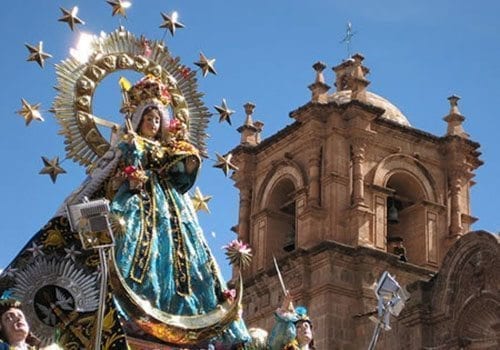Peru is a country with a cultural richness as vast as the gold once held by the ancient Incas. This wealth has given rise to countless beliefs, rituals, traditions, and expressions of devotion that have shaped the nation’s identity over centuries.
In pre-Columbian times, the Incas worshipped a pantheon of deities, rooted in nature and the cosmos. With the arrival of the Spanish conquest came not only colonization and upheaval but also the introduction of Christianity and Catholicism. Over time, new beliefs merged with ancient customs, giving birth to a deeply syncretic culture that still resonates today.
One of the most heartfelt and spectacular expressions of this fusion is the Festival of the Virgin of Candelaria, celebrated with great passion in the southern region of Puno. Promperu invites both locals and international travelers to experience this unforgettable celebration—an explosion of music, dance, costumes, and spiritual devotion.
Recognized by UNESCO as Intangible Cultural Heritage of Humanity, the Festival of the Virgin of Candelaria stands among the most vibrant religious and cultural events in all of Latin America.
Among the festival’s highlights are two major dance competitions. The traditional dance contest showcases indigenous performances in authentic attire from every corner of Puno. Equally stunning is the mestizo dance contest, where folkloric groups parade in brilliantly colored and illuminated costumes, filling the streets with rhythm and life.
These events unfold from January 29 through February 5, offering an entire week of folklore, beauty, joy, faith, and cultural pride.
On February 6, the festival concludes with a grand finale: the Great Parade and Veneration of the Virgin of Candelaria. Thousands of dancers take to the streets of Puno in a vibrant three-kilometer procession—not merely to perform, but to radiate joy, spirituality, and devotion to the beloved Virgin of Light.
It’s important to remember that the vast majority of Peruvians today identify with Christianity and Catholicism, both introduced by European missionaries during the colonial era. Over the centuries, the veneration of saints and Marian figures like the Virgin of Candelaria has become deeply embedded in the nation’s cultural fabric.
This sacred tradition is more than a religious act; it is a living testimony of Peru’s identity, blending faith, artistry, history, and community into a powerful expression of national heritage.



